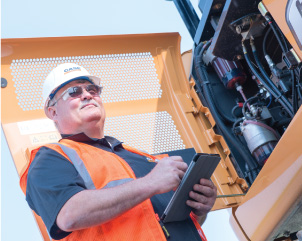Best Practices
Excavator Operation
Earthmoving projects pose a variety of dangers to excavator operators and anyone else on the jobsite. Follow our best practices below to ensure a safe project.
Preliminary Checkpoints
Check fuel levels
It sounds simple, but make sure the machine has enough fuel before putting it to work. Your
excavator should be able to operate at all times, allowing the user to dump unstable loads in
case of an emergency. Low fuel levels can shut an excavator down unexpectedly, causing a
potentially dangerous and unstable situation.
Attachment selection
Select an attachment that is approved by the manufacturer of the machine in use. Adhere to the
machine’s operators manual for safe operating ratios. Understand that the swing motor is the
weakest part of the excavator, and can be compromised by the weight of an attachment in variable
conditions.
Assess the ground
Inspect the jobsite for debris, loose soil, holes/ditches, inclines, and other obstacles. Even
if you know your machine, a rock, stump, or other hidden obstacle can cause your machine to
slide. If the machine catches an edge near any sort of incline or decline, tipping over becomes
a real possibility.
Know your articulated truck
If you will be loading an articulated truck, match the truck size to the excavator you are
using, or vice versa. It should take 3 to 5 bucket loads to fill the truck bed—Any more
than 5 and you are wasting time.
In Operation
Never undercut
An undercut occurs when an operator digs the ground beneath the excavator tracks. Always be
aware of the location of the lip of the hole that is being created to avoid a cave-in.
Don’t overload the bucket
Know your machine’s load limits and never exceed them, as overloading can cause loss in
stability and potential tip-overs.
Monitor your track position
When working on a hill, or any incline or decline, make sure your tracks are pointing up and
down the slope. Your tracks should never be parallel to the slope, as this distributes the
weight of the machine unevenly and can cause a roll over. Maintain a stable center of gravity at
all times.
Loading—Position the truck correctly
Position the truck on the left side of the excavator so the truck and excavator are facing
cab-to-cab. The truck should be stopped with the truck bed headboard in line with the rear of
the excavator cab. This allows the excavator operator clear visibility, since the boom is out of
the way. This technique gives the operator about a 25° swing into the truck, which is the most
efficient position for loading.

